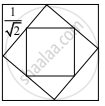Advertisements
Advertisements
Question
The midpoints of the sides of a square of side 1 are joined to form a new square. This procedure is repeated indefinitely. Find the sum of the areas of all the squares
Solution

Area of the 1st square = 12
Area of the 2nd square = `(1/sqrt2)^2`
Area of the 3rd square = `(1/2)^2`
and so on
∴ Sum of the areas of all the squares
= `1^2+(1/sqrt2)^2+(1/2)^2+...`
= `1+1/2+1/4+...`
∴ a = 1, r = `1/2`
Since, |r| = `|1/2|<1`
∴ sum to infinity exists.
∴ Sum of the areas of all the squares = `1/(1-1/2)` = 2
APPEARS IN
RELATED QUESTIONS
Find the sum to indicated number of terms in the geometric progressions x3, x5, x7, ... n terms (if x ≠ ± 1).
If the 4th, 10th and 16th terms of a G.P. are x, y and z, respectively. Prove that x, y, z are in G.P.
Find the sum to n terms of the sequence, 8, 88, 888, 8888… .
Insert two numbers between 3 and 81 so that the resulting sequence is G.P.
The first term of a G.P. is 1. The sum of the third term and fifth term is 90. Find the common ratio of G.P.
Show that the sequence <an>, defined by an = \[\frac{2}{3^n}\], n ϵ N is a G.P.
Which term of the progression 18, −12, 8, ... is \[\frac{512}{729}\] ?
Find three numbers in G.P. whose product is 729 and the sum of their products in pairs is 819.
Find the sum of the following geometric progression:
(a2 − b2), (a − b), \[\left( \frac{a - b}{a + b} \right)\] to n terms;
Find the sum of the following geometric progression:
4, 2, 1, 1/2 ... to 10 terms.
Find the sum of the following geometric series:
\[\frac{a}{1 + i} + \frac{a}{(1 + i )^2} + \frac{a}{(1 + i )^3} + . . . + \frac{a}{(1 + i )^n} .\]
Find the sum of the following serie:
5 + 55 + 555 + ... to n terms;
The sum of n terms of the G.P. 3, 6, 12, ... is 381. Find the value of n.
The ratio of the sum of first three terms is to that of first 6 terms of a G.P. is 125 : 152. Find the common ratio.
Show that the ratio of the sum of first n terms of a G.P. to the sum of terms from (n + 1)th to (2n)th term is \[\frac{1}{r^n}\].
Let an be the nth term of the G.P. of positive numbers.
Let \[\sum^{100}_{n = 1} a_{2n} = \alpha \text { and } \sum^{100}_{n = 1} a_{2n - 1} = \beta,\] such that α ≠ β. Prove that the common ratio of the G.P. is α/β.
Find the sum of the following serie to infinity:
8 + \[4\sqrt{2}\] + 4 + ... ∞
If a, b, c are in G.P., prove that log a, log b, log c are in A.P.
If a, b, c are in G.P., prove that:
(a + 2b + 2c) (a − 2b + 2c) = a2 + 4c2.
If pth, qth, rth and sth terms of an A.P. be in G.P., then prove that p − q, q − r, r − s are in G.P.
If pth, qth and rth terms of an A.P. and G.P. are both a, b and c respectively, show that \[a^{b - c} b^{c - a} c^{a - b} = 1\]
If the fifth term of a G.P. is 2, then write the product of its 9 terms.
Write the product of n geometric means between two numbers a and b.
If a = 1 + b + b2 + b3 + ... to ∞, then write b in terms of a.
If in an infinite G.P., first term is equal to 10 times the sum of all successive terms, then its common ratio is
The sum of an infinite G.P. is 4 and the sum of the cubes of its terms is 92. The common ratio of the original G.P. is
Given that x > 0, the sum \[\sum^\infty_{n = 1} \left( \frac{x}{x + 1} \right)^{n - 1}\] equals
For the G.P. if a = `2/3`, t6 = 162, find r.
A ball is dropped from a height of 80 ft. The ball is such that it rebounds `(3/4)^"th"` of the height it has fallen. How high does the ball rebound on 6th bounce? How high does the ball rebound on nth bounce?
Mosquitoes are growing at a rate of 10% a year. If there were 200 mosquitoes in the beginning. Write down the number of mosquitoes after n years.
The sum of an infinite G.P. is 5 and the sum of the squares of these terms is 15 find the G.P.
Select the correct answer from the given alternative.
The tenth term of the geometric sequence `1/4, (-1)/2, 1, -2,` ... is –
Select the correct answer from the given alternative.
The sum of 3 terms of a G.P. is `21/4` and their product is 1 then the common ratio is –
Answer the following:
For a sequence Sn = 4(7n – 1) verify that the sequence is a G.P.
Answer the following:
Find the nth term of the sequence 0.6, 0.66, 0.666, 0.6666, ...
Answer the following:
If a, b, c are in G.P. and ax2 + 2bx + c = 0 and px2 + 2qx + r = 0 have common roots then verify that pb2 – 2qba + ra2 = 0
If a, b, c, d are in G.P., prove that a2 – b2, b2 – c2, c2 – d2 are also in G.P.
For a, b, c to be in G.P. the value of `(a - b)/(b - c)` is equal to ______.
Find a G.P. for which sum of the first two terms is – 4 and the fifth term is 4 times the third term.
